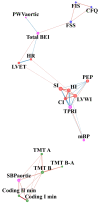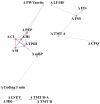Changes in the Allostatic Response to Whole-Body Cryotherapy and Static-Stretching Exercises in Chronic Fatigue Syndrome Patients vs. Healthy Individuals
- PMID: 34202023
- PMCID: PMC8268724
- DOI: 10.3390/jcm10132795
Changes in the Allostatic Response to Whole-Body Cryotherapy and Static-Stretching Exercises in Chronic Fatigue Syndrome Patients vs. Healthy Individuals
Abstract
This study represents a comparison of the functional interrelation of fatigue and cognitive, cardiovascular and autonomic nervous systems in a group of Chronic Fatigue Syndrome (CFS) patients compared with those in healthy individuals at different stages of analysis: at baseline and after changes induced by whole-body cryotherapy (WBC) combined with a static-stretching (SS) program. The study included 32 patients (Fukuda criteria) and 18 healthy controls. Fatigue, cognitive, cardiovascular and autonomic function and arterial stiffness were measured before and after 10 sessions of WBC with SS. In the patients, a disturbance in homeostasis was observed. The network relationship based on differences before and after intervention showed comparatively higher stress and eccentricity in the CFS group: 50.9 ± 56.1 vs. 6.35 ± 8.72, p = 0.002, r = 0.28; and 4.8 ± 0.7 vs. 2.4 ± 1, p < 0.001, r = 0.46, respectively. Before and after intervention, in the CFS group increased fatigue was related to baroreceptor function, and baroreceptor function was in turn related to aortic stiffness, but no such relationships were observed in the control group. Differences in the network structure underlying the interrelation among the four measured criteria were observed in both groups, before the intervention and after ten sessions of whole cryotherapy with a static stretching exercise.
Keywords: cold therapy; physical activity; stretching.
Conflict of interest statement
The authors declare no conflict of interest.
Figures







Similar articles
-
Combination of whole body cryotherapy with static stretching exercises reduces fatigue and improves functioning of the autonomic nervous system in Chronic Fatigue Syndrome.J Transl Med. 2022 Jun 17;20(1):273. doi: 10.1186/s12967-022-03460-1. J Transl Med. 2022. PMID: 35715857 Free PMC article.
-
Effects of whole-body cryotherapy and static stretching are maintained 4 weeks after treatment in most patients with chronic fatigue syndrome.Cryobiology. 2023 Sep;112:104546. doi: 10.1016/j.cryobiol.2023.05.003. Epub 2023 May 23. Cryobiology. 2023. PMID: 37230457
-
Erratum.Mult Scler. 2016 Oct;22(12):NP9-NP11. doi: 10.1177/1352458515585718. Epub 2015 Jun 3. Mult Scler. 2016. PMID: 26041800
-
The Role of Autonomic Function in Exercise-induced Endogenous Analgesia: A Case-control Study in Myalgic Encephalomyelitis/Chronic Fatigue Syndrome and Healthy People.Pain Physician. 2017 Mar;20(3):E389-E399. Pain Physician. 2017. PMID: 28339438
-
Is chronic fatigue syndrome in older patients a different disease? -- a clinical cohort study.Eur J Clin Invest. 2013 Mar;43(3):302-8. doi: 10.1111/eci.12046. Epub 2013 Feb 9. Eur J Clin Invest. 2013. PMID: 23397955
Cited by
-
Combination of whole body cryotherapy with static stretching exercises reduces fatigue and improves functioning of the autonomic nervous system in Chronic Fatigue Syndrome.J Transl Med. 2022 Jun 17;20(1):273. doi: 10.1186/s12967-022-03460-1. J Transl Med. 2022. PMID: 35715857 Free PMC article.
-
Recent research in myalgic encephalomyelitis/chronic fatigue syndrome: an evidence map.Health Technol Assess. 2025 Mar 26:1-78. doi: 10.3310/BTBD8846. Online ahead of print. Health Technol Assess. 2025. PMID: 40162526 Free PMC article.
-
Cardiopulmonary and metabolic responses during a 2-day CPET in myalgic encephalomyelitis/chronic fatigue syndrome: translating reduced oxygen consumption to impairment status to treatment considerations.J Transl Med. 2024 Jul 5;22(1):627. doi: 10.1186/s12967-024-05410-5. J Transl Med. 2024. PMID: 38965566 Free PMC article.
References
-
- Vitenet M., Tubez F., Marreiro A., Polidori G., Taiar R., Legrand F., Boyer F. Effect of whole body cryotherapy interventions on health-related quality of life in fibromyalgia patients: A randomized controlled trial. Complement. Ther. Med. 2018;36:6–8. doi: 10.1016/j.ctim.2017.10.011. - DOI - PubMed
LinkOut - more resources
Full Text Sources

